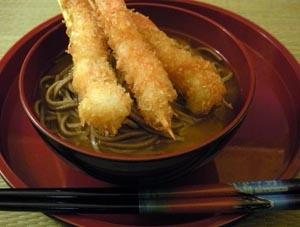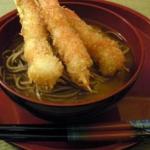Recipe: Toshikoshi Soba with Panko-Crusted Shrimp
When translated into English, "toshikoshi" means "year passing", and these savory and satisfying noodles are a tasty tradition to be enjoyed at midnight on NewYear's Eve. There is no specific recipe for Toshikoshi Soba, although for this occasion, they are typically served hot rather than cold. The broth might be green tea, or the kelp and bonito stock called dashi, or a special broth called tsuyu, flavored with soy sauce, sugar, and rice wine. And sometimes, the milky leftover water used for boiling the soba is added to the sauce.
Toppings for soba noodles might include finely chopped scallions, bits of seaweed, spinach leaves, grated yam, slices of kamaboko fish cakes, mochi dumplings, golden fried tofu (which makes it Kitsune Soba), bits of crispy-fried tempura batter (which makes it Tanuki Soba), or a raw egg (which makes it 'moon-viewing' Tsukimi Soba). So choose your favorite broth and toppings, and enjoy. Here is one tasty idea:
Toshikoshi Soba with Panko-Crusted Prawns
Shrimp:
12 large shrimp, peeled, tails intact
1 cup panko (more if needed)
1 egg, lightly beaten
Vegetable oil for deep-frying
Set up egg and panko in two shallow dishes. Dip each of the shrimp into the beaten egg, and then dredge in the panko. Heat about 1" of vegetable oil in a wok (oil is hot enough when a bit of panko and egg coating sizzles). Slightly reduce heat, add breaded shrimp a few at a time, and fry until golden brown on both sides. Drain shrimp on paper towels and set aside until serving time.
Noodles:
4 servings soba noodles
6 cups dashi (see recipe below)
1/4 cup soy sauce
1/4 cup miso
Bring the dashi and soy sauce to a simmer in a saucepan. Add soba noodles and miso and simmer until noodles are tender, about five minutes. Transfer noodles and broth to individual serving bowls and top with shrimp. Serves 4.
Basic Dashi:
The base for many Japanese soups is a stock called dashi. To make dashi, you will need:
6 cups water
One 4" piece of kombu (dried sea kelp)
One cup of katsuo-bushi (dried bonito shavings)
Rinse or wipe the dusty coating from the surface of the kombu and place in a pot with 6 cups of water and bring to a simmer. Just before the water comes to a boil, remove and discard the kombu. Add the katsuo-bushi and bring just to a simmer again. Remove the pan from the heat and allow it to cool. Strain the liquid into a separate container and discard the katsuo-bushi. The remaining liquid is called dashi and can be used as a base to make a wide variety of soups and dipping sauces.
 ThingsAsian
ThingsAsian
















